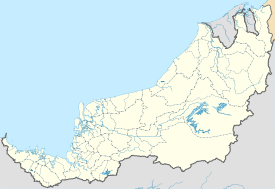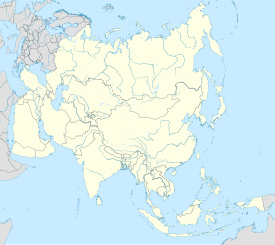
Back كوتشينغ Arabic Kuching AST Kuçinq Azerbaijani کوچینق AZB Kuching BCL Кучинг Bulgarian Kuching, Sarawak BJN কুচিং Bengali/Bangla Kuching Catalan Kuching (kapital sa estado) CEB
Kuching | |
|---|---|
| City of Kuching Bandar Raya Kuching | |
| Other transcription(s) | |
| • Jawi | کوچيڠ |
| • Chinese | 古晋 Gǔjìn (Hanyu Pinyin) |
| • Tamil | கூச்சிங் Kūcciṅ (Transliteration) |
From top, left to right: Kuching skyline from Sarawak River, the Sarawak State Museum, Fort Margherita, The Astana, the Darul Hana bridge near State Assembly building, Chinatown, and iconic cat statues. | |
| Nickname(s): "Cat City", Bandaraya Perpaduan (City of Unity) | |
 Location of Kuching in Sarawak | |
| Coordinates: 01°33′27″N 110°20′38″E / 1.55750°N 110.34389°E | |
| Country | |
| State | |
| Division | Kuching |
| District | Kuching |
| Founded by the Sultanate of Brunei | 1827 |
| Settled by James Brooke | 18 August 1842 |
| Municipality status | 1 January 1953 |
| City status | 1 August 1988 |
| Government | |
| • Type | City council |
| • Body | Commission of Kuching North City Hall Council of the City of Kuching South |
| • Mayor of Kuching North | Hilmy Othman |
| • Mayor of Kuching South | Wee Hong Seng |
| Area | |
• City of Kuching | 450.02 km2 (173.75 sq mi) |
| • Metro | 2,770.90 km2 (1,069.85 sq mi) |
| • Kuching North | 378.20 km2 (146.02 sq mi) |
| • Kuching South | 71.82 km2 (27.73 sq mi) |
| Elevation | 8 m (26 ft) |
| Highest elevation | 810.2 m (2,658.1 ft) |
| Lowest elevation | 0 m (0 ft) |
| Population (2021)[5] | |
• City of Kuching | 402,738 |
| • Density | 754.33/km2 (1,953.7/sq mi) |
| • Metro | 723,854 |
| • Metro density | 336.8/km2 (872/sq mi) |
| • Demonym | Kuchingite / Orang Kuching |
| (Sourced from Department of Statistics Malaysia (DoSM), 2022) | |
| Time zone | UTC+8 (MST) |
| • Summer (DST) | UTC+8 (Not observed) |
| Postal code | 93xxx |
| Area code(s) | 082 (landline only) |
| Vehicle registration | QA and QK (for all vehicles except taxis) HQ (for taxis only) |
| Website | Kuching North: dbku Kuching South: mbks |
Kuching (/ˈkuːtʃɪŋ/ KOO-ching, Malay: ['kutʃɪŋ]) officially the City of Kuching,[6] is the capital and the most populous city in the state of Sarawak in Malaysia.[7] It is also the capital of Kuching Division. The city is on the Sarawak River at the southwestern tip of Sarawak on the island of Borneo and covers an area of 431 km2 (166 sq mi) with a population about 165,642 in the Kuching North administrative region and 159,490 in the Kuching South administrative region[8][9][10]—a total of 325,132 people.[8]
Kuching was the third capital of Sarawak in 1827 during the administration of the Bruneian Empire. In 1841, Kuching became the capital of the Kingdom of Sarawak after the territory in the area was ceded to James Brooke for helping the Bruneian Empire in crushing a rebellion particularly by the interior Borneo-dwelling Land Dayak people who later became his loyal followers after most of them were pardoned by him and joined his side. The town continued to receive attention and development during the rule of Charles Brooke such as the construction of a sanitation system, hospital, prison, fort, and a bazaar. In 1941, the Brooke administration had a Centenary Celebration in Kuching. During World War II, Kuching was occupied by Japanese forces from 1942 to 1945. The Japanese government set up a Batu Lintang camp near Kuching to hold prisoners of war and civilian internees. After the war, the town survived intact. However, the last Rajah of Sarawak, Sir Charles Vyner Brooke decided to cede Sarawak as part of British Crown Colony in 1946. Kuching remained as capital during the Crown Colony period. After the formation of Malaysia in 1963, Kuching retained its status as state capital and was granted city status in 1988. Since then, Kuching is divided into two administrative regions managed by two separate local authorities Mohd Azri Bin Subohi. The administrative centre of the Sarawak State Government is located at Wisma Bapa Malaysia, Kuching.
Kuching is a major food destination and is a member of UNESCO's Creative Cities Network under the field of gastronomy.[11] Kuching is also the main gateway for travellers visiting Sarawak and Borneo.[12] Kuching Wetlands National Park is located about 30 km (19 mi) from the city and there are many other tourist attractions in and around Kuching such as Bako National Park, Semenggoh Wildlife Centre, Rainforest World Music Festival (RWMF), state assembly building, The Astana, Fort Margherita, Kuching Cat Museum, and Sarawak State Museum / Borneo Cultures Museum. The city has become one of the major industrial and commercial centres in East Malaysia.[13][14]
- ^ "Briefing By The Mayor of Kuching North". Kuching North City Hall. Economic Planning Unit (Prime Minister's Department Malaysia). Archived from the original on 19 December 2013. Retrieved 19 December 2013.
- ^ "Kuching, Malaysia - Weather History and Climate Data". World Climate. Archived from the original on 1 December 2014. Retrieved 28 March 2015.
- ^ "Malaysia Elevation Map (Elevation of Kuching)". Flood Map : Water Level Elevation Map. Archived from the original on 22 August 2015. Retrieved 22 August 2015.
- ^ Cite error: The named reference
Santubongwas invoked but never defined (see the help page). - ^ "Malaysia Population 2019". World Population Review. 4 February 2019. Retrieved 19 April 2019.
- ^ "City of Kuching Ordinance" (PDF). Sarawak State Attorney-General's Chambers. 1988. p. 3 (Chapter 48).
- ^ The Report: Sarawak 2011. Oxford Business Group. 2011. pp. 13–. ISBN 978-1-907065-47-7. Retrieved 18 July 2013.
- ^ a b "Population Distribution by Local Authority Areas and Mukims, 2010 (page 1 & 8)" (PDF). Department of Statistics, Malaysia. Archived from the original (PDF) on 5 February 2015. Retrieved 19 July 2013.
- ^ Trudy Ring; Robert M. Salkin; Sharon La Boda (January 1996). International Dictionary of Historic Places: Asia and Oceania. Taylor & Francis. pp. 497–498. ISBN 978-1-884964-04-6.
- ^ Christina Umpi (2011). "A review of the centralized sewerage system for Kuching City" (PDF). Faculty of Engineering. Universiti Malaysia Sarawak. Archived from the original (PDF) on 31 December 2017. Retrieved 31 December 2017.
- ^ "Kuching | Creative Cities Network". en.unesco.org. Retrieved 23 September 2022.
- ^ John Brunton (21 January 2017). "Kuching, Malaysia: what to see plus the best restaurants, hotels and bars". The Guardian. Archived from the original on 31 December 2017. Retrieved 31 December 2017.
- ^ Raymond Frederick Watters; T. G. McGee (1997). Asia-Pacific: New Geographies of the Pacific Rim. Hurst & Company. pp. 311–. ISBN 978-1-85065-321-9.
- ^ The Report: Sarawak 2008. Oxford Business Group. 2008. pp. 30, 56, 69 & 136. ISBN 978-1-902339-95-5.












